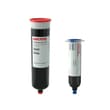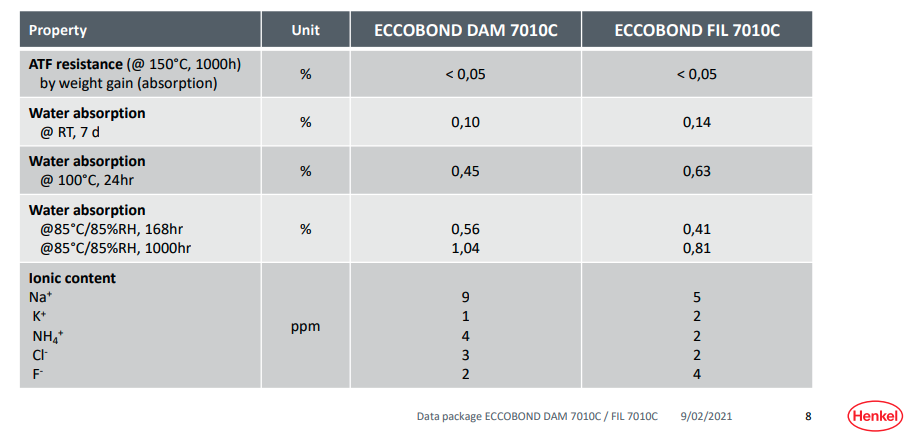LOCTITE ECCOBOND 7010C DAM
- Dam
- Low CTE
- High purity
Product Description
LOCTITE ECCOBOND DAM 7010C is a black epoxy semiconductor encapsulant, formulated to be used in combination with a "fill" encapsulant LOCTITE ECCOBOND FIL 7010C as a dam encapsulant. It is specially designed for glob top, chip on board applications where protection of wire bonded bare IC is required. This two material combination is also suited for the protection of multiple chips and for encapsulating components where a well-defined glob height and flat surface are required.
LOCTITE ECCOBOND DAM 7010C has good crack, chemical and thermal resistance along with low thermal expansion. This SVHC free, REACH compliant, high purity, low sag material operates at -40 to 150ºC and is typically used for glob top applications and the encapsulation of bare wire bonded semiconductors.
Cure Schedule
- 2 hours @ 140°C
- 1 hour @ 100°C plus 1 hour @ 150°C (Low Stress)
Technical Specifications
| General Properties | |||||||||
| |||||||||
| Physical Properties | |||||||||
| Thixotropic index Thixotropic index Thixotropic Index is a ratio of a material s viscosity at two different speeds in Ambient temperature, generally different by a factor of ten. A thixotropic material s viscosity will decrease as agitation or pressure is increased. It indicates the capability of a material to hold its shape. Mayonnaise is a great example of this. It holds its shape very well, but when a shear stress is applied, the material easily spreads. It helps in choosing a material in accordance to the application, dispense method and viscosity of a material. | 3 | ||||||||
| Viscosity Viscosity Viscosity is a measurement of a fluid’s resistance to flow. Viscosity is commonly measured in centiPoise (cP). One cP is defined as the viscosity of water and all other viscosities are derived from this base. MPa is another common unit with a 1:1 conversion to cP. A product like honey would have a much higher viscosity -around 10,000 cPs- compared to water. As a result, honey would flow much slower out of a tipped glass than water would. The viscosity of a material can be decreased with an increase in temperature in order to better suit an application | 90,000 mPa.s | ||||||||
| Chemical Properties | |||||||||
| |||||||||
| Mechanical Properties | |||||||||
| |||||||||
| Electrical Properties | |||||||||
| Volume Resistivity Volume Resistivity Volume resistivity, also called volume resistance, bulk resistance or bulk resistivity is a thickness dependent measurement of the resistivity of a material perpendicular to the plane of the surface. | 9.0x10-15 Ohms⋅cm | ||||||||
| Thermal Properties | |||||||||
| |||||||||
| Glass Transition Temperature (Tg) Glass Transition Temperature (Tg) The glass transition temperature for organic adhesives is a temperature region where the polymers change from glassy and brittle to soft and rubbery. Increasing the temperature further continues the softening process as the viscosity drops too. Temperatures between the glass transition temperature and below the decomposition point of the adhesive are the best region for bonding. The glass-transition temperature Tg of a material characterizes the range of temperatures over which this glass transition occurs. | 135 °C | ||||||||
| Thermal Conductivity Thermal Conductivity Thermal conductivity describes the ability of a material to conduct heat. It is required by power packages in order to dissipate heat and maintain stable electrical performance. Thermal conductivity units are [W/(m K)] in the SI system and [Btu/(hr ft °F)] in the Imperial system. | 0.78 W/m.K | ||||||||




